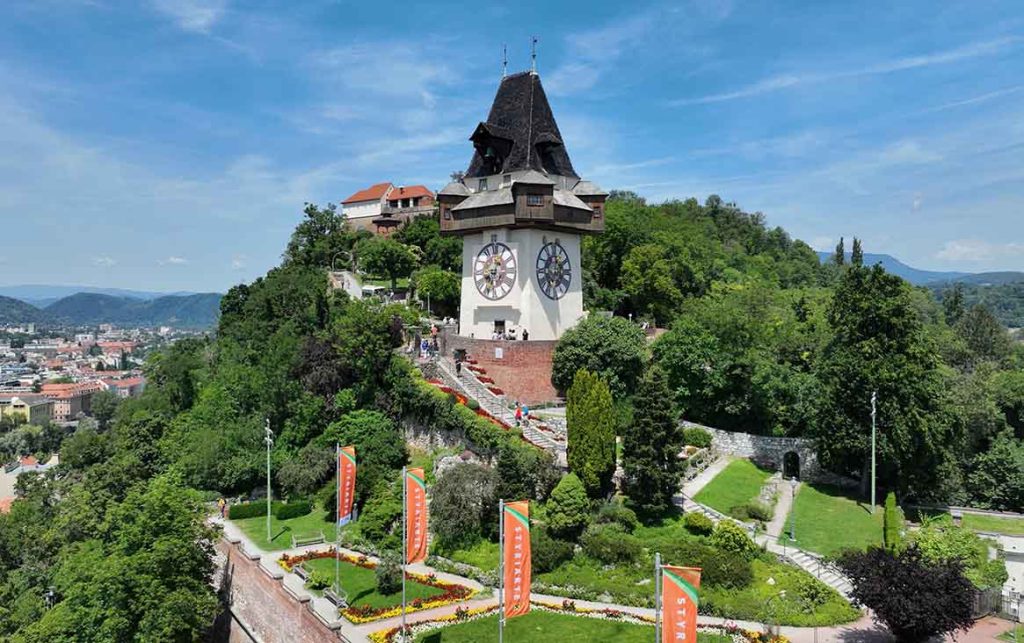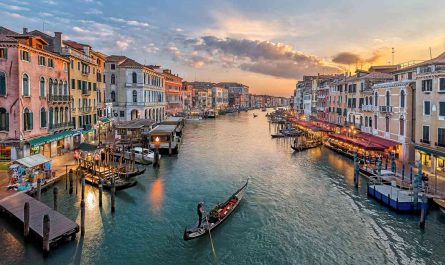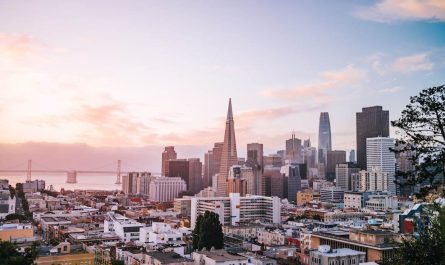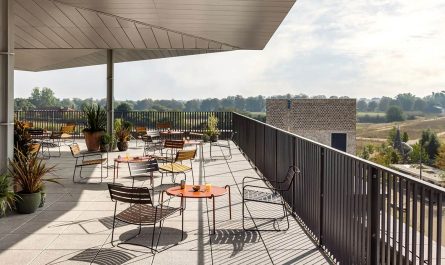I first came across Graz in a European architecture travel guide. At the time, I didn’t know much about Austria’s second-largest city—only that it wasn’t as grandiose as Vienna, nor as musically renowned as Salzburg. Yet this understated city quietly boasts a UNESCO World Heritage old town and boldly embraces avant-garde design. Murinsel (Mur Island)—a glass structure floating in the center of the Mur River like a futuristic spaceship—is the perfect embodiment of Graz’s fusion of the classical and the modern
That day, I wandered through the old town after lunch, strolling along cobbled streets warmed by sunlight. Suddenly, a silver bridge appeared before me, and at its center was an alien-like island as if it had landed from outer space. Its sleek lines and translucent materials resembled a sliced-open glass drifting bottle, quietly floating on the river. In that moment, I knew I had to go inside.
The Past and Present of Mur Island
Murinsel isn’t a natural island, but a masterfully designed artificial structure that challenges the boundaries of architecture and public art. It was conceived by visionary New York architect Vito Acconci in 2003, specifically to celebrate Graz’s designation as the European Capital of Culture. Acconci imagined something that would not only float but connect—both banks of the Mur River, and the past and future of the city. The entire structure is 47 meters long and 20 meters wide, shaped like a twisting double helix. From above, it looks like a sculptural seashell hollowed out by water and time, gracefully floating on the surface of the river.
Originally, this bold installation was only meant to last a year—an ephemeral experiment, a temporary gesture. But something unexpected happened. The people of Graz fell in love with it. Children played in its curves, students gathered there at night, artists hosted events under its glass canopy. It became more than a structure—it became part of the city’s collective rhythm. The authorities eventually decided to preserve it permanently, and today, Murinsel serves not only as a visual symbol of Graz’s artistic soul but as a functional space integrated into everyday life. It houses a cozy café where people sip espresso and watch the water drift by, a small open-air theater that comes alive in summer with music and poetry, and a quirky playground area where children can scramble and imagine. Murinsel is no longer just a design statement—it is a living piece of the city.
Stepping Into the Glass Drifting Bottle
I stepped onto the bridge leading to Mur Island. Sunlight shimmered on the river, casting silver reflections. Reaching the center of the island, I was greeted by a transparent dome in hues of blue and white. Sunlight filtered through the glass, filling the space with a soft, warm glow.
At the heart of the island lies a café called Insel Café, one of my favorite spots from this trip. Though small, every seat offers a view of the flowing Mur River and the red rooftops on the opposite bank. I ordered an espresso and a slice of Styrian apple cake, then took a window-side seat and watched as the city’s rhythm shimmered in the river’s reflections. Outside the glass wall, a breeze stirred a few fallen leaves—like a quiet footnote of time.
Beyond the café, the island also houses a miniature open-air theater. On summer evenings, it often hosts musical performances, experimental theater, or poetry readings. One time, I was lucky to catch a jazz performance by local youths. The audience seating was just beside the café—no need to change seats to immerse oneself in the show. That evening, saxophone notes echoed within the glass structure, while nightfall wrapped the city like a soft veil.

The Design Charm of Mur Island
What makes Mur Island so captivating is how it seamlessly integrates design into everyday urban life. Unlike many architectural landmarks that remain distant or static, Mur Island invites interaction and participation. Children laugh as they dash along the curved bridge corridor, their footsteps echoing joyfully against the structure. Couples lean on the cool glass railings, quietly sharing a moment above the gentle murmur of the river. Tourists, like myself, sit in the café, sipping coffee while marveling at this surreal, floating space. Architect Acconci described it as a “walk-through sculpture”—a poetic notion brought vividly to life here. He erased the lines between observation and involvement, between static art and living function. This inclusive, human-centered approach to design touched me deeply and helped me see architecture not only as form and function, but as experience.
In daylight, Mur Island appears radiant and crystalline, with sunlight refracting through its glass panels and dancing across the café floor. Come nightfall, it transforms. LED outlines softly illuminate the curves, and the entire structure glows like a firefly drifting in still water. It feels like stepping into the set of a sci-fi dream, yet grounded in the pulse of real city life. Even a simple stroll across the bridge can stir a quiet awe—an everyday magic sparked by thoughtful, bold design.
Daily Life Beyond Design
After leaving Mur Island, I continued my walk north along the Mur River, where the pace of life slows and the scenery opens into a harmonious blend of nature and culture. On one side, the iconic Schlossberg hill rises, crowned by the centuries-old clock tower that has watched over Graz for generations. Its stone walls and winding trails whisper of medieval times. On the opposite bank, sleek glass buildings and creative co-working spaces speak to the city’s forward-looking mindset. This striking visual and historical contrast doesn’t clash—instead, it weaves a rhythm unique to Graz, one that pulses with both memory and momentum.
The city seems to understand how to let old and new coexist, not in competition but in conversation. As I walked, I passed cyclists, families with strollers, and students sitting on benches sketching the riverside view. Just a few steps away from Mur Island stands the Kunsthaus Graz—nicknamed the “Friendly Alien” due to its organic, blob-like form and glossy blue skin. Together, these two structures form a dialogue: one floating above the water like a dream, the other rooted in the urban landscape, constantly evolving with exhibitions and ideas. They are two facets of the same spirit—the spirit of a city that places design at the heart of daily life.

Tips for the Best Experience
- Visit at sunrise or sunset: These moments offer the most breathtaking atmosphere. At dawn, soft pastels gently color the sky, and the island seems to stretch and wake with the river. At sunset, the golden hues turn the glass structure into a glowing lantern, casting warm reflections across the water. For photographers and romantics alike, it’s a moment worth pausing for.
- Bring a book or journal: There’s something about this island—its calm, its openness—that invites introspection. On my second visit, I brought along a travel journal and sat for nearly two hours, watching people pass, jotting down reflections, and letting the ambience soak in. It’s the perfect place to feel suspended between movement and stillness.
- Attend a performance: Mur Island truly comes alive during events. Music seems to echo longer, words linger more gently, and the glass dome offers a natural amphitheater effect. Even spontaneous street performances gain a sense of theater here. Check local schedules—you might just stumble upon a moment that turns into a treasured memory.
- Combine it with Kunsthaus: The synergy between Mur Island and the Kunsthaus is undeniable. Exploring both offers a complete picture of Graz’s design ethos. From organic forms and high-tech installations to interactive exhibits and urban nature, this short walking route becomes a rich sensory and intellectual journey—compact yet unforgettable.
A Souvenir of Memory from Mur Island
Before leaving, I stepped into a small corner of the café where a few shelves displayed local souvenirs—each item subtly echoing the island’s design language. Among them, a delicate glass pendant caught my eye: a miniature drifting bottle made from recycled Murinsel glass. Inside, a tiny hand-rolled scroll bore the words: “Design is the bridge between dream and daily life.” I bought it without hesitation, knowing I’d treasure it long after I left Austria.
That pendant, like the island itself, became a metaphor for what Graz had given me. Mur Island wasn’t just a beautiful object or a place to take photos—it was a space that breathed, connected, and inspired. Through it, I realized that a city’s magic often lies not only in its monuments, but in how it invites people to inhabit, interpret, and feel part of its story. Graz, with this drifting bottle of glass, reminded me that design isn’t just about how things look—it’s about how they live, and how they help us live better too. It gave me not just a view, but a memory—a fleeting moment turned timeless.



